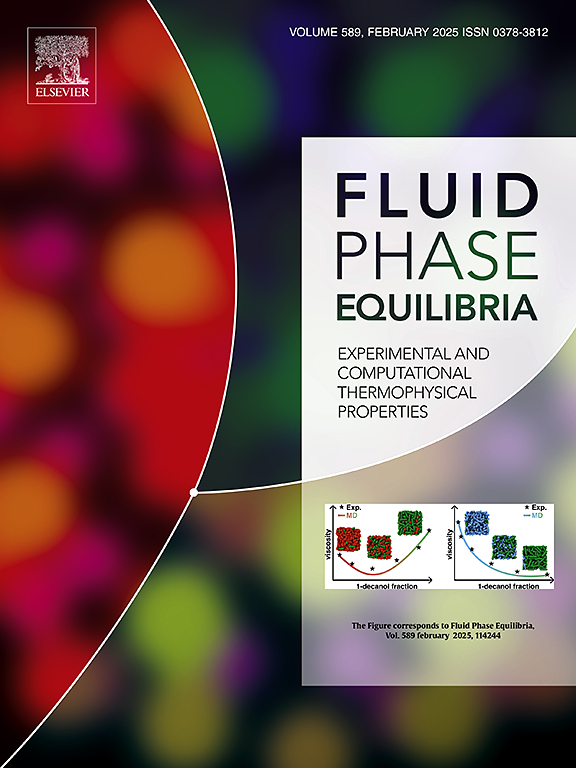Prediction of gas hydrates phase equilibrium in porous media – Pore size effect and thermodynamics approach
IF 2.8
3区 工程技术
Q3 CHEMISTRY, PHYSICAL
引用次数: 0
Abstract
Rapid growth in conventional energy consumption has drawn attention to renewable resources and unconventional fossil energy sources, such as Natural Gas Hydrates (NGHs). Comprehensive knowledge of the NGH accumulation conditions is the basis of exploration and exploitation. The mechanisms and factors, related with sediments and their matrix characteristics, and thermodynamic conditions affect the formation and dissociation of NGHs in sediments. Thermodynamic data on hydrate formation in porous media is limited due to the time-consuming and complex nature of obtaining experimental data. The use of thermodynamic models capable of predicting hydrate formation conditions is highly beneficial for studying gas extraction from hydrate reservoirs. In this research, previously published experimental data and modeling were analyzed. The impact of pore size on the formation of natural gas hydrates (NGHs) was modeled using two different thermodynamic approaches (fugacity and activity models), and their adaptation to experimental data was studied. The outcomes of the thermodynamic models revealed that the fugacity and activity model exhibited overall average absolute percent deviation (AAD%) 2.89 and 4.6 %, respectively. Minimum and maximum percentages of the average absolute deviation (AAD%) in fugacity model at 1.05 % and 5.5 %, respectively. Meanwhile, the activity model showed a minimum deviation of 1.67 % and a maximum deviation of 9.22 %. Additionally, it was observed that as the pore size diameter approaches approximately 100 nm, the equilibrium hydrate pressure in porous media and the equilibrium pressure in pure water become close. The surface tension of 0.039(J/m²) proposed by Uchida et al. leads to accurate modeling of methane hydrate in porous media.
多孔介质中天然气水合物相平衡预测——孔径效应和热力学方法
常规能源消费的快速增长引起了人们对可再生能源和非常规化石能源的关注,如天然气水合物。全面认识天然气水合物成藏条件是勘探开发的基础。沉积物及其基质特征、热力学条件等因素影响沉积物中天然气水合物的形成和解离。由于获得实验数据的耗时和复杂性,多孔介质中水合物形成的热力学数据有限。利用能够预测水合物形成条件的热力学模型,对研究水合物气藏的开采具有重要意义。在本研究中,分析了先前发表的实验数据和模型。采用两种不同的热力学方法(逸度模型和活度模型)模拟了孔隙大小对天然气水合物形成的影响,并研究了它们与实验数据的适应性。热力学模型结果表明,逸度和活度模型的总体平均绝对百分比偏差(AAD%)分别为2.89和4.6%。逸度模型平均绝对偏差(AAD%)的最小和最大百分比分别为1.05%和5.5%。同时,活度模型最小偏差为1.67%,最大偏差为9.22%。另外,当孔径接近100 nm时,多孔介质中的平衡水合物压力与纯水中的平衡水合物压力接近。Uchida等人提出的0.039(J/m²)的表面张力可以精确模拟多孔介质中的甲烷水合物。
本文章由计算机程序翻译,如有差异,请以英文原文为准。
求助全文
约1分钟内获得全文
求助全文
来源期刊

Fluid Phase Equilibria
工程技术-工程:化工
CiteScore
5.30
自引率
15.40%
发文量
223
审稿时长
53 days
期刊介绍:
Fluid Phase Equilibria publishes high-quality papers dealing with experimental, theoretical, and applied research related to equilibrium and transport properties of fluids, solids, and interfaces. Subjects of interest include physical/phase and chemical equilibria; equilibrium and nonequilibrium thermophysical properties; fundamental thermodynamic relations; and stability. The systems central to the journal include pure substances and mixtures of organic and inorganic materials, including polymers, biochemicals, and surfactants with sufficient characterization of composition and purity for the results to be reproduced. Alloys are of interest only when thermodynamic studies are included, purely material studies will not be considered. In all cases, authors are expected to provide physical or chemical interpretations of the results.
Experimental research can include measurements under all conditions of temperature, pressure, and composition, including critical and supercritical. Measurements are to be associated with systems and conditions of fundamental or applied interest, and may not be only a collection of routine data, such as physical property or solubility measurements at limited pressures and temperatures close to ambient, or surfactant studies focussed strictly on micellisation or micelle structure. Papers reporting common data must be accompanied by new physical insights and/or contemporary or new theory or techniques.
 求助内容:
求助内容: 应助结果提醒方式:
应助结果提醒方式:


